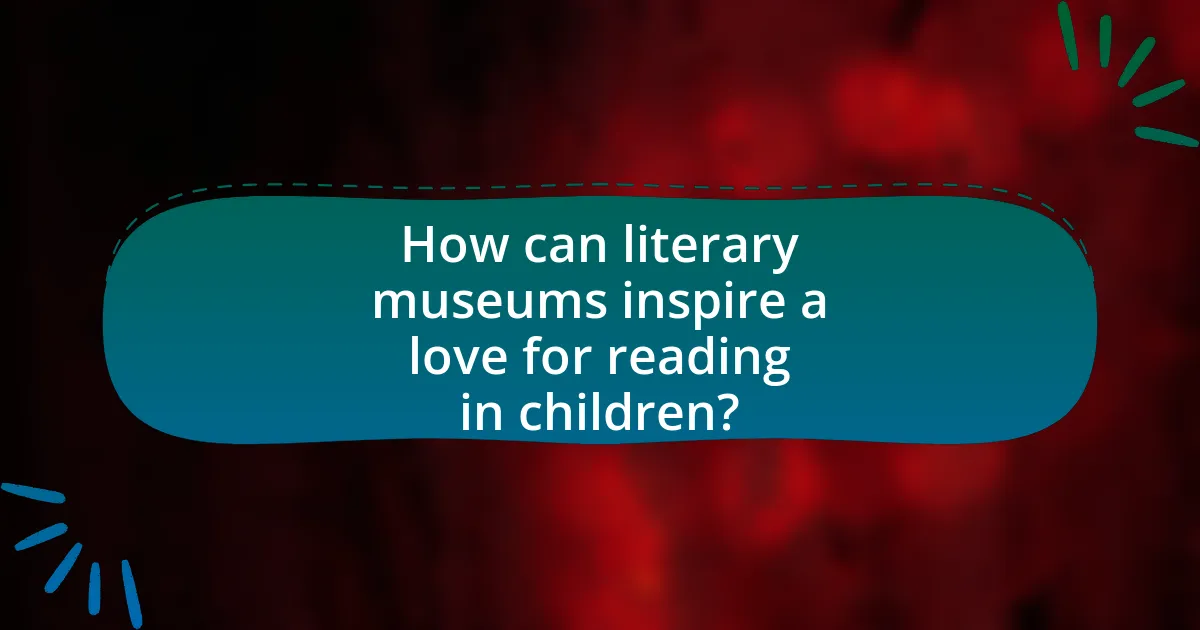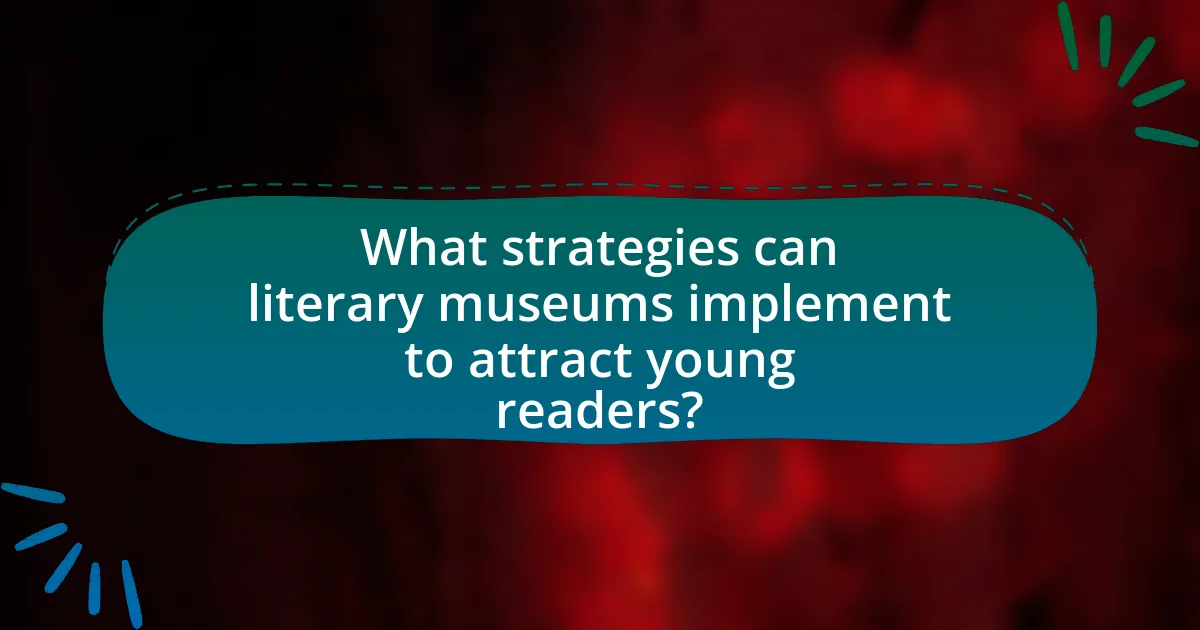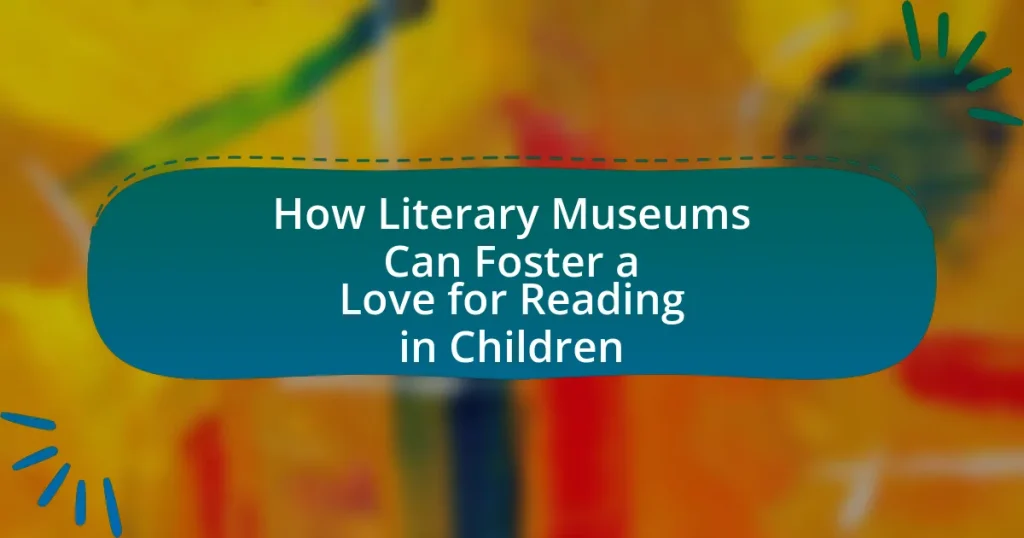Literary museums serve as vital institutions in fostering a love for reading among children by offering immersive and interactive experiences that connect them with literature and its creators. Through storytelling sessions, workshops, and engaging exhibits, these museums promote literacy and enhance children’s cognitive development, imagination, and empathy. The article explores the role of literary museums in promoting literacy, the impact of interactive elements on reading experiences, and effective strategies for attracting young readers, including partnerships with schools and local authors. Additionally, it highlights the long-term benefits of reading and the importance of feedback in improving museum programs.

How can literary museums inspire a love for reading in children?
Literary museums can inspire a love for reading in children by providing immersive experiences that connect them with literature and its creators. These museums often feature interactive exhibits, storytelling sessions, and workshops that engage children in the narrative process, making reading more relatable and enjoyable. For instance, studies have shown that children who participate in interactive literary programs are more likely to develop positive attitudes toward reading, as these experiences foster curiosity and imagination. Additionally, literary museums often showcase the works of beloved authors, allowing children to explore the context and inspiration behind the stories, which can deepen their appreciation for reading.
What role do literary museums play in promoting literacy?
Literary museums play a crucial role in promoting literacy by providing interactive and educational experiences that engage visitors with literature. These museums often host exhibitions, workshops, and reading programs that encourage exploration of literary works and authors, fostering a deeper understanding and appreciation of reading. For instance, the American Writers Museum offers hands-on exhibits and storytelling sessions that attract children and families, thereby enhancing literacy skills through active participation. Additionally, literary museums frequently collaborate with schools to create programs that align with educational standards, further reinforcing their impact on literacy development.
How do exhibits engage children’s imaginations?
Exhibits engage children’s imaginations by providing interactive and immersive experiences that stimulate creativity and curiosity. These environments often incorporate hands-on activities, storytelling elements, and visual displays that encourage children to explore narratives and characters actively. For instance, studies show that children who participate in interactive exhibits demonstrate higher levels of engagement and imaginative play, which enhances their cognitive development and fosters a love for reading. By allowing children to visualize stories and interact with literary themes, exhibits create a dynamic space where imagination can flourish.
What interactive elements can enhance the reading experience?
Interactive elements that can enhance the reading experience include multimedia displays, touchscreens, and augmented reality features. These elements engage children by allowing them to interact with the content, making reading more immersive and enjoyable. For instance, multimedia displays can present animated illustrations or audio narrations that complement the text, while touchscreens can offer interactive quizzes or games related to the story. Augmented reality features can bring characters to life, encouraging children to explore narratives in a dynamic way. Research shows that interactive reading experiences can improve comprehension and retention, as children are more likely to engage with material that stimulates multiple senses.
Why is fostering a love for reading important for children?
Fostering a love for reading is crucial for children because it enhances their cognitive development and academic success. Research indicates that children who engage in regular reading demonstrate improved vocabulary, comprehension skills, and critical thinking abilities. For instance, a study published in the journal “Reading Research Quarterly” found that early exposure to reading significantly correlates with higher literacy rates and better performance in school. Additionally, reading fosters empathy and emotional intelligence, as children learn to understand diverse perspectives through stories. Thus, nurturing a passion for reading equips children with essential skills for lifelong learning and personal growth.
What are the long-term benefits of reading for children?
Reading provides children with long-term benefits such as enhanced cognitive development, improved language skills, and increased empathy. Engaging with books stimulates brain development, leading to better critical thinking and problem-solving abilities. Research indicates that children who read regularly perform better academically, as reading enhances vocabulary and comprehension skills, which are crucial for learning across subjects. Additionally, studies show that reading fiction can foster empathy by allowing children to understand diverse perspectives and emotions, contributing to their social and emotional growth.
How does reading influence cognitive development?
Reading significantly influences cognitive development by enhancing language skills, critical thinking, and comprehension abilities. Engaging with texts stimulates brain activity, leading to improved vocabulary and grammar understanding, which are essential for effective communication. Research indicates that children who read regularly demonstrate higher levels of cognitive skills, including problem-solving and analytical thinking. A study published in the journal “Child Development” by authors such as McGowan and Kuhl (2018) found that early exposure to reading correlates with better academic performance and cognitive flexibility in later years. This evidence underscores the vital role of reading in shaping cognitive abilities during formative years.

What strategies can literary museums implement to attract young readers?
Literary museums can attract young readers by implementing interactive exhibits that engage them through technology and hands-on activities. For instance, incorporating augmented reality experiences allows visitors to interact with literary characters and stories in a dynamic way, making literature more relatable and exciting. Research indicates that interactive learning environments significantly enhance engagement and retention among younger audiences, as evidenced by studies showing that students retain 75% of what they learn through active participation compared to only 5% through passive listening. Additionally, hosting author events, workshops, and storytelling sessions tailored for children can create a community atmosphere that fosters a love for reading. These strategies not only draw young visitors but also encourage them to explore literature in a fun and meaningful way.
How can storytelling sessions be utilized in literary museums?
Storytelling sessions can be utilized in literary museums to engage children and enhance their appreciation for literature. These sessions create immersive experiences where children can connect with stories through interactive narration, fostering imagination and creativity. Research indicates that storytelling enhances language skills and comprehension, making it an effective educational tool. For instance, a study by the National Endowment for the Arts found that children who participate in storytelling activities show improved literacy outcomes. By incorporating storytelling sessions, literary museums can effectively promote a love for reading among young audiences.
What types of stories resonate most with children?
Stories that resonate most with children typically include themes of adventure, friendship, and imagination. These narratives often feature relatable characters and situations that allow children to see themselves in the story, fostering emotional connections. Research indicates that children are particularly drawn to stories with fantastical elements, such as talking animals or magical worlds, as these stimulate their creativity and curiosity. For example, a study published in the Journal of Child Language found that children engage more deeply with stories that incorporate elements of fantasy, enhancing their cognitive and emotional development.
How can storytelling be made interactive?
Storytelling can be made interactive by incorporating elements that engage the audience actively, such as choose-your-own-adventure formats, multimedia presentations, and live performances. These methods allow participants to influence the narrative direction, enhancing their emotional investment and engagement. For example, research shows that interactive storytelling can improve comprehension and retention in children, as evidenced by a study published in the Journal of Educational Psychology, which found that children who participated in interactive storytelling sessions demonstrated a 30% increase in story recall compared to traditional storytelling methods.
What partnerships can enhance the museum’s reading programs?
Collaborations with local schools and libraries can significantly enhance the museum’s reading programs. These partnerships allow for the integration of educational resources and outreach initiatives that promote literacy. For instance, joint events such as reading workshops or author visits can attract families and encourage children to engage with literature in a museum setting. Additionally, partnerships with educational organizations can provide access to specialized programs and funding, further enriching the museum’s offerings. Research indicates that collaborative efforts between museums and educational institutions lead to increased participation and improved literacy outcomes among children.
How can schools collaborate with literary museums?
Schools can collaborate with literary museums by organizing joint educational programs that enhance students’ understanding of literature. These programs can include guided tours of the museum, interactive workshops led by museum staff, and author talks that connect students with literary figures. For instance, a study by the American Alliance of Museums highlights that such collaborations can increase student engagement and foster a deeper appreciation for reading by providing hands-on experiences with literary artifacts and historical contexts.
What role do local authors and illustrators play in museum programs?
Local authors and illustrators play a crucial role in museum programs by enhancing educational experiences and fostering community engagement. Their involvement often includes conducting workshops, readings, and interactive sessions that connect children with literature and art, making the museum a dynamic space for learning. For instance, programs featuring local authors can introduce children to storytelling techniques, while illustrators can demonstrate the creative process behind visual storytelling. This direct interaction not only enriches the museum’s offerings but also helps cultivate a love for reading and creativity among young visitors, as evidenced by increased participation in literary activities and positive feedback from families.

What specific programs can literary museums offer to engage children?
Literary museums can offer interactive storytelling sessions to engage children. These sessions allow children to participate in the narrative, enhancing their imagination and comprehension skills. Additionally, workshops focused on creative writing encourage children to express themselves and develop their writing abilities. Programs that include scavenger hunts based on literary themes can also captivate children’s interest while teaching them about different authors and genres. Evidence shows that hands-on activities, such as crafting book-related art projects, can significantly increase children’s enthusiasm for reading and literature.
How can workshops and creative activities promote reading?
Workshops and creative activities can promote reading by engaging children in interactive and hands-on experiences that make literature more accessible and enjoyable. These activities often incorporate storytelling, art, and performance, which help to stimulate children’s imagination and interest in books. For instance, research shows that children who participate in creative workshops related to literature demonstrate increased motivation to read, as they associate reading with fun and creativity. A study by the National Endowment for the Arts found that children who engage in arts-related activities are more likely to develop a lifelong interest in reading and literature.
What types of workshops are most effective for children?
Interactive storytelling workshops are most effective for children. These workshops engage children through participatory activities that enhance their comprehension and creativity. Research indicates that interactive storytelling can improve language skills and foster a love for reading, as children are more likely to connect with narratives when they actively participate. A study published in the Journal of Educational Psychology found that children who participated in storytelling workshops showed a 30% increase in vocabulary retention compared to those who did not. This evidence supports the effectiveness of interactive storytelling workshops in promoting literacy and a passion for reading among children.
How can creative writing activities be integrated into museum visits?
Creative writing activities can be integrated into museum visits by designing interactive workshops that encourage children to respond to exhibits through storytelling. For instance, museums can provide prompts related to specific artifacts or artworks, allowing children to create narratives that connect their imagination with historical or cultural contexts. Research indicates that hands-on engagement, such as writing stories inspired by museum displays, enhances cognitive retention and emotional connection to the material, fostering a deeper appreciation for literature and history.
What events can be organized to celebrate literature among children?
Literary museums can organize various events to celebrate literature among children, including storytelling sessions, book fairs, writing workshops, and author meet-and-greets. Storytelling sessions engage children by bringing stories to life, fostering imagination and a love for narratives. Book fairs provide access to a wide range of literature, encouraging children to explore different genres and authors. Writing workshops allow children to express their creativity and develop writing skills, while author meet-and-greets offer unique opportunities for children to interact with writers, inspiring them through personal connections to literature. These events collectively promote literacy and a lifelong appreciation for reading.
How can book fairs and reading challenges be structured?
Book fairs can be structured by organizing them around specific themes, such as genres or age groups, and incorporating interactive activities like author signings, storytelling sessions, and workshops. Reading challenges can be structured by setting clear goals, such as the number of books to read within a certain timeframe, and providing incentives like rewards or recognition for participants who meet these goals. Research indicates that themed events and interactive elements significantly increase engagement and participation, fostering a deeper love for reading among children.
What role do themed events play in attracting young readers?
Themed events play a crucial role in attracting young readers by creating immersive experiences that engage their interests and imagination. These events often incorporate popular themes from literature, such as fantasy or adventure, which resonate with children and encourage them to explore related books. For instance, a literary museum hosting a Harry Potter-themed event can draw in young fans, leading to increased foot traffic and participation in reading activities. Research indicates that interactive and themed programming can enhance children’s motivation to read, as evidenced by a study published in the Journal of Educational Psychology, which found that children exposed to themed reading events showed a 30% increase in reading engagement compared to those who did not participate.
What are some best practices for literary museums to foster a love for reading?
Literary museums can foster a love for reading by creating interactive exhibits that engage visitors, particularly children, in the storytelling process. These exhibits can include hands-on activities, such as writing workshops and storytelling sessions, which encourage participation and creativity. Research indicates that interactive learning experiences significantly enhance engagement and retention, making reading more appealing to young audiences. Additionally, literary museums can host author readings and book signings, providing children with direct connections to the authors and their works, which can inspire a deeper interest in literature. By incorporating technology, such as augmented reality experiences that bring stories to life, museums can further captivate young readers and make literature more accessible and exciting.
How can feedback from children and parents improve programs?
Feedback from children and parents can significantly improve programs by providing insights into their experiences and preferences. When children express their interests and challenges, programs can be tailored to engage them more effectively, enhancing their enjoyment and learning outcomes. Parents can offer perspectives on what resonates with their children, allowing programs to align with family values and expectations. Research indicates that programs incorporating participant feedback see increased satisfaction and participation rates, as evidenced by a study from the National Endowment for the Arts, which found that arts programs that adapt based on audience input lead to higher engagement levels.
What resources are essential for successful reading initiatives?
Essential resources for successful reading initiatives include access to diverse reading materials, trained educators, and community engagement programs. Diverse reading materials, such as books from various genres and cultures, cater to different interests and reading levels, fostering inclusivity and engagement. Trained educators are crucial as they provide guidance and support, helping children develop reading skills effectively. Community engagement programs, such as reading clubs and events, encourage participation and create a supportive environment for young readers. Research indicates that initiatives combining these resources can significantly improve literacy rates and foster a lifelong love for reading among children.


